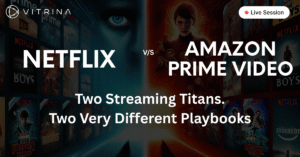Content Financing Deal Flow Monitoring: A Strategic Guide for Executives

Introduction
The global media and entertainment industry is driven by one core engine: a constant, insatiable demand for new content. For financiers, private equity firms, and content acquisition executives, this landscape presents a critical dual challenge.
On one hand, opportunities are abundant, with thousands of projects in development and production at any given moment. On the other, the traditional approach to tracking and vetting these opportunities—relying on fragmented data, personal networks, and manual outreach—is fundamentally broken.
This friction creates information asymmetry, leading to missed opportunities and a higher risk profile for every investment. Navigating this environment requires a disciplined, technology-led approach.
This guide will provide a strategic framework for modern content financing deal flow monitoring, outlining how to move from a reactive, manual process to a proactive, data-driven system that provides a competitive edge.
Table of content
- Understanding the Content Financing Deal Flow Challenge
- The Strategic Imperative of Proactive Deal Flow Monitoring
- Core Components of a Modern Deal Flow Monitoring Framework
- How a Technology-Led Approach Transforms Deal Flow
- How Vitrina Solves the Content Financing Deal Flow Problem
- Conclusion
- Frequently Asked Questions
Key Takeaways
| Core Challenge | Relying on manual, fragmented data to monitor and vet thousands of potential content financing opportunities. |
| Strategic Solution | Implement a technology-led deal flow monitoring framework that provides real-time, centralized intelligence. |
| Vitrina’s Role | A centralized platform for tracking film & TV projects, vetting companies, and identifying collaborators. |
Understanding the Content Financing Deal Flow Challenge
For executives in content acquisition and financing, a deal is more than a transaction; it is a long-term strategic bet on creative talent, market viability, and financial return.
The process of deal flow—the pipeline of potential investments—is the lifeblood of this business. Yet, the sources for this pipeline are vast and decentralized, ranging from film festivals and talent agency lists to trade publications and word-of-mouth.
The sheer volume and velocity of new projects make it nearly impossible to maintain a comprehensive view without a strategic system.
The core challenge is a lack of structured, verified intelligence. While precise public data on the volume of new projects in development is limited, industry trends indicate a significant growth in the sheer number of projects.
This makes it increasingly difficult for financiers to get ahead of the curve. The current environment is characterized by information asymmetry. A finance executive might learn about a project’s development only after it has been announced, at which point the best opportunities may have already been secured.
The manual process of tracking projects involves multiple disparate tools: static spreadsheets, email threads, and a web of unverified contacts. This fragmented approach not only consumes valuable time but also increases the risk of overlooking a viable project or misjudging a partner’s track record, leading to an ill-informed investment decision.
This is precisely where modern deal flow monitoring becomes not just a convenience, but a strategic imperative.
The Strategic Imperative of Proactive Deal Flow Monitoring
Effective deal flow monitoring is the foundation of a proactive investment strategy. In an industry where a project’s value can fluctuate wildly based on its creative team, timing, and market position, having early and accurate intelligence is the single greatest competitive advantage.
This strategic approach allows executives to de-risk investments by identifying key trends and collaborators before the market becomes aware of them.
A robust system for content financing deal flow monitoring enables you to:
- Identify Early Signals: Recognize emerging projects in their development or pre-production stages when deal terms are most flexible.
- Improve Due Diligence: Vetting potential collaborators and creative partners is a crucial step in content financing. A centralized system provides the historical data and context needed to make informed decisions about who you partner with.
- Streamline Your Pipeline: A unified view of all potential deals, from initial scout to final negotiation, allows you to manage your resources more effectively and ensures no opportunity falls through the cracks.
- Spot Undervalued Opportunities: By systematically tracking a wider range of projects, you can uncover hidden gems that may be overlooked by competitors relying on a limited network.
Core Components of a Modern Deal Flow Monitoring Framework
A successful framework for content financing deal flow monitoring is built on three key pillars: project intelligence, company vetting, and efficient pipeline management. These components work together to provide a holistic and actionable view of the market.
Project Intelligence & Sourcing Early Signals
At the top of the funnel is the ability to discover new film and TV projects as soon as they are announced, often before they appear on major databases. This requires tracking announcements from trade publications, international film markets, and other sources that are often overlooked in a manual process.
The key is to capture not just the project’s title, but also its genre, logline, key personnel, and current stage of development. This allows you to quickly filter for projects that align with your investment thesis, whether that’s a specific genre, budget, or territory.
Vetting Partners for Due Diligence
A project is only as strong as the team behind it. Vetting the collaborators involved—from the director and producers to the co-production partners and sales agents—is critical. You need a system that can provide a clear view of a company’s past successes, deal history, and financial standing.
This process goes beyond a simple web search; it requires a structured database that can connect a company’s profile to its past projects and key personnel, giving you a complete picture of its reputation and credentials.
This is particularly vital in cross-border transactions, where reputation and credentials can be difficult to verify. For a deeper understanding of this challenge, explore our analysis of the pain points in cross-border transactions.
Managing a Centralized Deal Pipeline
Once a project has been identified and the key partners vetted, the next step is to manage it through your pipeline. A modern framework should allow you to track each project’s progress, assign due diligence tasks, and collaborate with your team in a centralized location. This ensures a consistent process, reduces administrative overhead, and creates a single source of truth for all deal-related information.
How a Technology-Led Approach Transforms Deal Flow
The challenges outlined above highlight a clear market need for a technology solution that can aggregate, verify, and structure the fragmented data of the entertainment supply chain.
The shift from manual processes to a technology-led approach is no longer optional. It is the key to managing the scale and complexity of the global market. The future of deal flow isn’t about having a larger Rolodex, but about having a more intelligent one, powered by data.
By moving your pipeline from scattered spreadsheets to an integrated platform, you can significantly reduce the high resource cost of building a business pipeline manually and find deals that others might miss. To learn more about how a comprehensive solution can address these challenges, explore our solutions page.
How Vitrina Solves the Content Financing Deal Flow Problem
Vitrina’s platform was purpose-built to address the complexities of the entertainment supply chain. As a global leader in tracking the M&E supply chain, Vitrina provides a comprehensive, data-driven approach to deal flow monitoring.
Instead of relying on manual research, Vitrina’s content financing deal flow monitoring solution provides a single source for real-time project intelligence. Its Project Tracker functionality tracks thousands of film and TV projects globally, from their early development stages through to production and release.
You can search by genre, territory, budget, and key crew members, giving you the ability to identify projects that align with your investment criteria as soon as they emerge.
The platform also centralizes the company and people data needed for due diligence. Vitrina profiles over 170,000 entertainment companies, from major studios and streamers to independent production houses and financiers.
Each company profile is linked to its full project history and key personnel, including over 3 million CXOs and department heads. This gives you the verified insights you need to confidently vet a potential partner’s track record and discover new collaborators.
Vitrina helps you connect the dots between projects, companies, and people in a way that is impossible with manual methods.
By providing a single platform for sourcing, tracking, and vetting, it provides the full toolkit required for modern deal flow management, allowing you to focus on the strategic decisions that truly matter. For a deeper look at this process, visit the Vitrina Project Tracker page.
Conclusion
The future of content financing is not about who you know; it is about what you know. In a market defined by global scale and a relentless pace of change, the traditional methods of deal flow management are no longer sufficient.
A strategic approach to content financing deal flow monitoring, enabled by a centralized technology platform, is now a requirement for success.
By focusing on early project intelligence, rigorous company vetting, and efficient pipeline management, executives can transition from a manual, reactive posture to a proactive, data-driven strategy that provides a clear competitive advantage. The ability to find, track, and vet thousands of new projects is no longer a luxury—it is the very foundation of intelligent investment.
Frequently Asked Questions
Deal flow refers to the stream of potential investment or acquisition opportunities that come to a financier, studio, or production company. In the entertainment industry, this includes new film and TV projects, libraries of content, or potential mergers with other companies.
Film financiers find projects through a variety of channels, including film markets, talent agencies, personal networks, and online databases. The process involves identifying a project in development, vetting the creative and business team, and conducting due diligence on its financial viability.
Content financing involves providing capital to fund the development and production of a new project. Content acquisition, in contrast, involves a company purchasing the distribution rights to a completed project or a library of existing content.
Content acquisition executives often rely on a combination of tools, including internal tracking systems, subscription-based industry databases, and direct contact with producers and distributors. Technology platforms that centralize and verify this information are increasingly used to streamline the process.















































